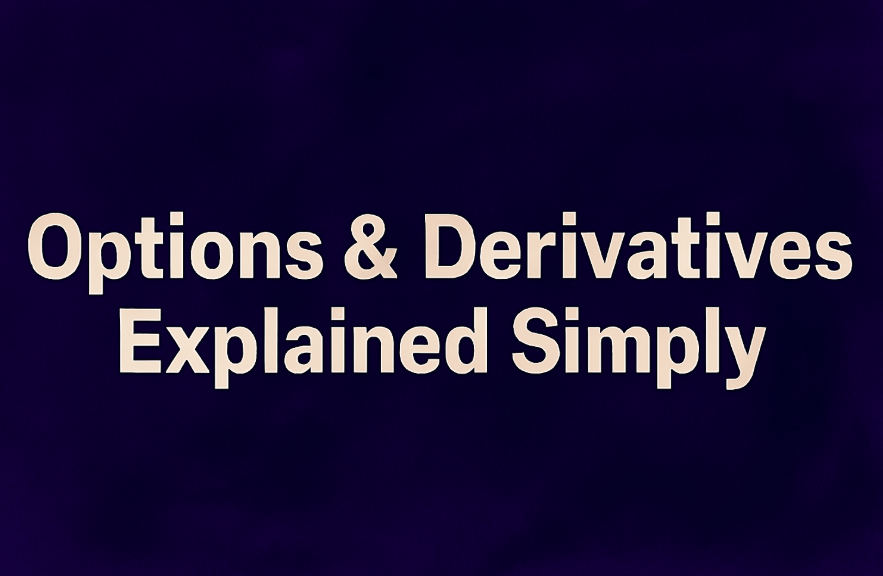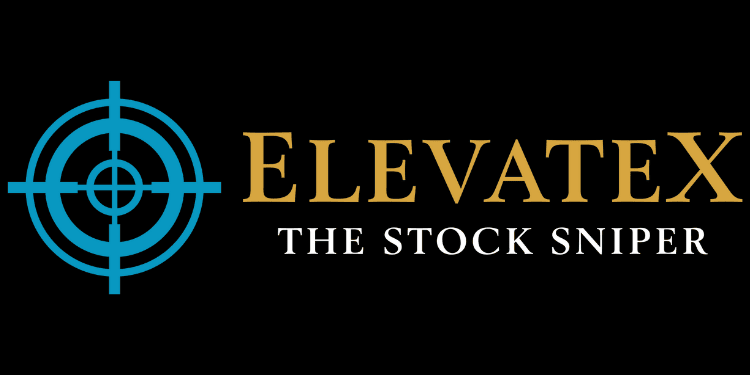- Live Life Grow Wealth
- Posts
- 🏦Series 6 Day 5: Options & Derivatives Explained Simply
🏦Series 6 Day 5: Options & Derivatives Explained Simply

Today’s Headline
🏦 Series 6: Advanced Topics (For Curious Learners)
Day 5: Options & Derivatives Explained Simply
When I first heard the words options and derivatives, I’ll be honest — they sounded intimidating. They felt like something only Wall Street traders or math geniuses would understand. But as I dug deeper, I realized that while the concepts can be complex, the core idea is actually quite simple. In this edition, I want to break it down for you in plain English so you can finally understand what these terms mean, why investors use them, and what kind of risks and opportunities they bring.
Let’s start from the beginning.
“Imagine converting your customer calls into revenue-generating assets — discover how Synthflow’s AI-powered WhatsApp & voice agents are being used by fintech firms to scale without hiring more staff.”
What Are Derivatives?
The word derivative means something that’s “derived from” something else.
In finance, a derivative is a contract whose value comes from another asset — like a stock, a commodity, a currency, or even an index.
Here’s an example:
Imagine you and I make a bet on the future price of gold. Gold is the underlying asset, and our bet — the agreement between us — is the derivative.
If gold’s price goes up, maybe you win. If it goes down, maybe I win.
But notice this — neither of us actually owns any gold! We’re just making an agreement based on what will happen to the price.
That’s the essence of derivatives. They derive their value from something else.
The Four Main Types of Derivatives
There are four main types you’ll often hear about:
Futures – Agreements to buy or sell an asset at a specific price in the future.
Forwards – Similar to futures, but usually private agreements between two parties instead of being traded on an exchange.
Options – Contracts that give the right, but not the obligation, to buy or sell an asset at a certain price before a set date.
Swaps – Agreements to exchange cash flows or interest rates between two parties.
Now don’t worry — you don’t have to remember all that right away. What’s important is to understand the logic: derivatives are tools that allow investors to manage risk, speculate, or protect themselves from price changes.
Why Do People Use Derivatives?
Here are a few common reasons:
Hedging: To protect against future price changes. For example, an airline might use derivatives to lock in the price of fuel so they won’t be hurt if oil prices skyrocket.
Speculation: Traders use derivatives to bet on price movements. If they predict correctly, they can make huge profits. If they’re wrong, they can lose a lot too.
Leverage: Derivatives allow investors to control large amounts of money with a smaller investment — but that also means the potential for loss is magnified.
So, while derivatives can be powerful tools, they also carry serious risks.
Now Let’s Talk About Options
Options are the most popular type of derivative for retail investors.
And here’s the simplest way to think about them: an option is like a coupon.
Let me explain.
There are two types of options — Call Options and Put Options.
A Call Option gives you the right to buy something at a certain price (called the strike price) before a certain date.
A Put Option gives you the right to sell something at a certain price before a certain date.
So, think of a call option like a shopping coupon.
Let’s say you have a coupon that lets you buy an iPhone for $900, even if the store later raises the price to $1,200. That coupon suddenly becomes very valuable.
In this example:
The iPhone is the underlying asset.
The coupon is the option.
The $900 price is the strike price.
If the market price goes above $900, your call option is worth money because you can buy it cheaper than everyone else.
But if the iPhone’s price falls to $700, your coupon becomes useless — why use it to buy at $900 when you can get it cheaper in the market? That’s the risk — your option expires worthless.
Options in the Stock Market
Now, let’s apply this to stocks.
If I believe a company’s stock will rise, I might buy a call option.
If I believe it will fall, I might buy a put option.
Each option comes with a price called the premium — that’s the amount you pay to buy the contract.
It’s like buying the coupon itself.
For example:
You buy a call option on Tesla with a strike price of $200, and it costs you $10.
If Tesla’s stock rises to $250, your option is worth at least $50 ($250 - $200).
You paid $10, so your profit is $40 per share — not bad!
But if Tesla’s stock stays below $200, your option expires worthless, and you lose the $10 premium.
That’s how options work in a nutshell — limited risk (you can only lose your premium) but unlimited potential gain.
Why Investors Love Options
Here’s why some investors use options:
Flexibility – You can profit whether prices go up, down, or even stay the same, depending on your strategy.
Leverage – You can control a large amount of stock for a small upfront cost.
Hedging – You can protect your portfolio from losses by using options as insurance.
For example, if you own a stock and worry it might fall, you can buy a put option to limit your losses. It’s like buying insurance on your investment.
While options sound exciting, they come with one big warning: leverage can magnify both profits and losses.
Imagine you invest $1000 in shares that move up 10%. You make $100.
But if you use options with 10x leverage, that same 10% move could make you $1000 — or lose you $1000 just as fast.
Leverage is like driving a car with a turbo engine — it gets you to your destination faster, but one wrong turn can wreck you.
That’s why it’s important to use options responsibly. Always remember: just because you can trade them doesn’t mean you should — not until you fully understand how they work.
Find your customers on Roku this Black Friday
As with any digital ad campaign, the important thing is to reach streaming audiences who will convert. To that end, Roku’s self-service Ads Manager stands ready with powerful segmentation and targeting options. After all, you know your customers, and we know our streaming audience.
Worried it’s too late to spin up new Black Friday creative? With Roku Ads Manager, you can easily import and augment existing creative assets from your social channels. We also have AI-assisted upscaling, so every ad is primed for CTV.
Once you’ve done this, then you can easily set up A/B tests to flight different creative variants and Black Friday offers. If you’re a Shopify brand, you can even run shoppable ads directly on-screen so viewers can purchase with just a click of their Roku remote.
Bonus: we’re gifting you $5K in ad credits when you spend your first $5K on Roku Ads Manager. Just sign up and use code GET5K. Terms apply.
Real-World Example: Hedging with Options
Let’s say you own shares of Apple worth $10,000. You’re worried that the stock might drop soon, but you don’t want to sell your shares.
You can buy a put option that allows you to sell your Apple shares at a fixed price, say $160, even if the market price falls below that.
If Apple’s price drops to $140, your put option protects you. You can still sell at $160, minimizing your loss.
If Apple’s price goes up, you lose the small premium you paid for the option — but your stock gains in value, so you still win overall.
That’s the beauty of using options strategically — they can act as insurance for your investments.
Why Options Exist
Options and derivatives might seem like complex financial tools, but they exist for very practical reasons:
To reduce risk (hedging).
To increase potential returns (speculating).
To improve efficiency in financial markets.
However, they’re not for everyone. Beginners often get lured in by the idea of quick profits, not realizing how easily they can lose money if they don’t understand the mechanics.
The Psychological Trap
Here’s something I’ve noticed among many new investors — when they discover options, they get addicted to the “what ifs.”
“What if this stock doubles?”
“What if I use leverage and make 10 times more?”
This kind of thinking can be dangerous. It turns investing into gambling.
Smart investors use options as tools for strategy — not luck.
Before you trade an option, ask yourself:
Do I understand what I’m risking?
Am I prepared to lose the premium I pay?
Is this decision based on a solid plan or just emotion?
If you can answer confidently, you’re thinking like a professional.
Key Takeaways
Let’s sum everything up clearly:
Derivatives are financial contracts that get their value from something else.
Options are a type of derivative that give you the right (not obligation) to buy or sell at a set price.
Call options = right to buy.
Put options = right to sell.
Derivatives can help manage risk or increase profits, but they can also multiply losses if not used carefully.
Always understand the product before you invest.
My Personal Advice
When I first learned about options, I made the mistake of thinking I could outsmart the market. I bought calls on a company I believed would skyrocket — but it didn’t, and the option expired worthless.
That loss taught me something priceless: understanding is more important than excitement.
So if you ever plan to use derivatives or options, take your time to study them first.
Read, ask questions, and start small.
The goal isn’t to gamble your way to wealth — it’s to build lasting financial knowledge and discipline.
Final Takeaways
Options and derivatives can be your best friends or your worst enemies.
Used wisely, they can protect your portfolio and help you make strategic gains.
Used carelessly, they can drain your money faster than you can react.
As you continue your investing journey, remember: knowledge is your best defense.
If today’s lesson opened your eyes to how powerful — and risky — these tools are, make a commitment to learn one new thing about investing every day.
In tomorrow’s issue, we’ll dive even deeper into practical ways to strengthen your investment strategy.
Until then, stay curious, stay informed, and most importantly — keep growing your wealth the smart way.
[Live Life Grow Wealth]
🎓 Free Masterclasses to Unlock Your Investment Potential
Take your money skills to the next level with expert-led workshops designed to help you grow smarter and faster.
Recommendations Section
“Peek into smart money moves — when big players act, you’re in the loop.”
|
Learn simple, proven ways to grow your money — straight from real investors who walk the talk.
|
“Hone your investing edge in just 5 minutes — smart, snappy insights to power your portfolio growth.”
|
“Stay ahead with one expert-picked stock monthly — clear, no jargon, built for growth.”
DISCLAIMER
I make no representations, warranties, or guarantees, whether expressed or implied, that the content provided is accurate, complete, or up-to-date. Past performance is not indicative nor a guarantee of future returns.
I am an individual content creator and not regulated or licensed by the Monetary Authority of Singapore (MAS) as I do not provide investment services.
All forms of investments carry risks, including the risk of losing your entire invested amount. Such activities may not be suitable for everyone. You are strongly encouraged to seek advice from a professional financial advisor if you have any doubts or concerns.







